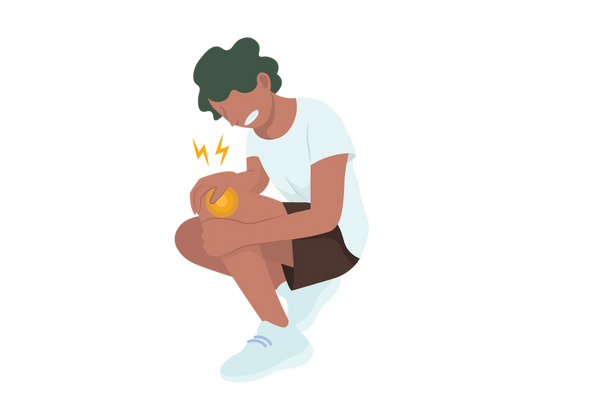Iliotibial band syndrome quiz
Take a quiz to find out if you have iliotibial band syndrome.
Iliotibial band syndrome quiz
Take a quiz to find out if you have iliotibial band syndrome.
What is iliotibial band syndrome?
The iliotibial (IT) band is a thick tissue (fascia) that runs from the top of the hip, along the outer thigh, and just past the knee. Its main function is to stabilize the knee during activity.
IlioIliotibial band syndrome occurs when the IT band becomes tight, causing pain or discomfort. When you move—for instance, run or squat—that tight band rubs against the bones of your knee. This causes friction that irritates the surrounding tissue. The result is pain and swelling along the outside of the knee.
Iliotibial band syndrome often occurs in endurance athletes like long distance runners and cyclists, particularly when they’re ramping up the intensity of their training. The pain usually develops over time, from a few months to even a few years. It tends to be worse after repetitive knee exercises (like cycling).
It often gets better or disappears with rest, followed by consistent stretching exercises.
What does band pain feel like?
Dr. Rx
Be sure to tell your doctor your usual and desired activity levels. Have an idea of what makes the pain worse (for example, running), and what makes it better (for example, rest or Advil). —Dr. Debbie Dang
The most common symptom is aching pain along the outside of the knee, just above the knee joint. The pain is at its worst with repetitive moves, like running or cycling. The friction causes swelling and inflammation. Symptoms develop slowly and there is often no history of an injury.
Main symptoms
- Aching pain along the outer side of the knee, just above the knee joint itself.
- Swelling over the IT band as it runs on the outer side of the knee.
- Pain that worsens with endurance activities and improves with rest.
Iliotibial band syndrome quiz
Take a quiz to find out if you have iliotibial band syndrome.
Causes of iliotibial band syndrome
The IT band normally glides over a ridge of bone at your knee as you bend and straighten the leg. If it’s tight, the band can rub against this ridge. That friction leads to swelling and inflammation, which causes pain.
Iliotibial band syndrome frequently happens in people that do activities with repetitive knee flexion (bending the knee) and extension (straightening the knee).
A common risk factor is having a tight IT band. But other biomechanical issues can also cause it like an imbalance in the strength of your hip muscles, differences in foot position (like when your foot turns in, called pronation), and overextension at the knee.
It can also develop from improper stretching and shoes that are not properly fitted or supportive.
Pro Tip
You will most likely get back to your desired activity level with the proper rest, therapy, and stretching regimen. —Dr. Dang
Next steps
Iliotibial band syndrome is not dangerous. Continuing to exercise and move with the pain doesn’t normally risk permanent damage. But often, people naturally change their exercise habits to avoid the pain, which helps symptoms heal on their own.
When symptoms really become bothersome, ask your doctor to recommend a physical therapist or a sports medicine specialist. Your doctor may order an X-ray to rule out other problems. But you won’t need any other tests for them to diagnose you.
Pro Tip
Many patients think that they need advanced imaging, such as an MRI or a CT scan for diagnosis. In fact, this condition is best diagnosed based on history (your story) and a physical exam by your doctor. —Dr. Dang
How do you treat iliotibial band syndrome?
Treating IT band syndrome usually requires a two-pronged approach: managing the pain and stretching and strengthening the affected tissue.
If your IT band hurts, you should rest, ice the outside of the knee, and take a non-steroidal antiinflammatory drug (NSAID), such as ibuprofen or naproxen. This can help temporarily.
Once the pain subsides, start gentle stretching exercises on your own, and gradually return to your prior activity level, letting pain be a guide.
If the pain persists or returns, especially when you’re moving around or exercising, see a physical therapist. They will teach you ways to stretch out the IT band and correct any anatomical imbalances that may be causing the pain, such as hip abductor muscle strengthening to help rebalance hip muscle strength. They may also do deep tissue massage.
Consistently doing physical therapy is the best way to keep the pain from coming back. But progress can be slow. Usually it takes months, and in some cases, up to a year.
If the pain is severe, your doctor may give you a steroid injection right into the area that hurts. This will help decrease inflammation and hopefully provide some relief until physical therapy kicks in.
Most cases of IT band syndrome don’t require surgery. Usually, the risks of surgery far outweigh any potential benefits. Your doctor will only consider it if your pain is extremely bad and every other treatment option has failed.
Ready to treat your iliotibial band syndrome?
We show you only the best treatments for your condition and symptoms—all vetted by our medical team. And when you’re not sure what’s wrong, Buoy can guide you in the right direction.See all treatment optionsIliotibial band syndrome quiz
Take a quiz to find out if you have iliotibial band syndrome.
Preventative tips
The best way to prevent IT band syndrome is to have a consistent stretching routine. Also, try not to suddenly increase your exercise intensity. Instead, gradually work up to your desired level of exercise over the course of days to weeks.
Was this article helpful?
